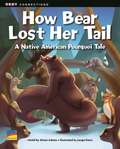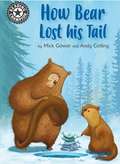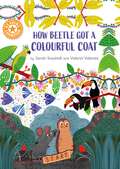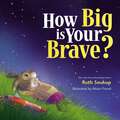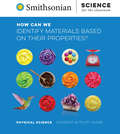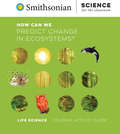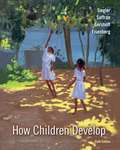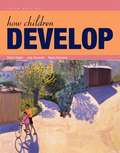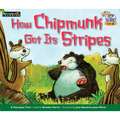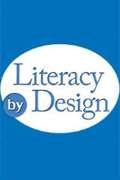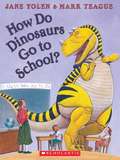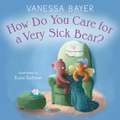- Table View
- List View
How Bear Lost Her Tail
by Alison Adams Jacqui Davis Jeffrey B. Fuerst"Look at how wonderful my tail is!" said Bear. Bear won't stop bragging about her big, brown tail. What will clever Fox do to teach her a lesson?
How Bear Lost His Tail: Independent Reading 11 (Reading Champion #298)
by Mick GowarA fun retelling of this Native American legend. Bear is tricked by Otter into fishing with his beautiful, long tail - and it ends up getting frozen and snapping off!Reading Champion offers independent reading books for children to practise and reinforce their developing reading skills.Fantastic, original stories are accompanied by engaging artwork and a reading activity. Each book has been carefully graded so that it can be matched to a child's reading ability, encouraging reading for pleasure.The Key Stage 2 Reading Champion Books are suggested for use as follows:Independent Reading 11: start of Year 3 or age 7+Independent Reading 12: end of Year 3 or age 7+Independent Reading 13: start of Year 4 or age 8+Independent Reading 14: end of Year 4 or age 8+Independent Reading 15: start of Year 5 or age 9+Independent Reading 16: end of Year 5 or age 9+Independent Reading 17: start of Year 6 or age 10+Independent Reading 18: end of Year 6 or age 10+
How Beetle got its Colourful Coat: Independent Reading Orange 6 (Reading Champion #1076)
by Sarah SnashallThis story is part of Reading Champion, a series carefully linked to book bands to encourage independent reading skills, developed with Dr Sue Bodman and Glen Franklin of UCL Institute of Education (IOE)Reading Champion offers independent reading books for children to practise and reinforce their developing reading skills.Fantastic, original stories are accompanied by engaging artwork and a reading activity. Each book has been carefully graded so that it can be matched to a child's reading ability, encouraging reading for pleasure. Perfect for 5-7 year olds or those reading book band orange.
How Bicycles Changed the World / Young Bike Racers (Fountas & Pinnell Classroom, Guided Reading Grade 4)
by Michael SandlerNIMAC-sourced textbook
How Big Is Big? How Far Is Far? (SEEDS Book Reader)
by Carolyn Jaynes John Erickson Mick CoulasNIMAC-sourced textbook
How Big Is Your Brave?
by Ruth SoukupHow do you teach a child to dream big and shoot for the stars? In this inspiring story, a young bunny named Zippy dreams of traveling to space. When the opportunity to attend space camp arrives, she worries she might not be capable enough to compete with other kids. But Zippy&’s desire to build her rocket is bigger than her fear of failing, and through hard work and creativity works to make her dreams come true.New York Times bestselling author Ruth Soukup empowers children everywhere to dream big and live a life they love. How Big Is Your Brave? encourages readers to face their fears and overcome obstacles in order to follow their dreams and reach their goals.How Big Is Your Brave? is:Great for boys and girls, ages 4–8An excellent choice for STEM storytime and sparking discussions about STEM fieldsA great resource to teach young children about confidence, self-esteem, and the value of hard workThrough whimsical illustrations and encouraging text, children will discover how standing up to fears (both big and small) makes them stronger and unstoppable.
How Butterflies Came to Be [On Level, Grade 2]
by Deborah November Gina CapaldiNIMAC-sourced textbook
How Can Animals Use Their Senses to Communicate?: Student Activity Guide
by The Smithsonian InstitutionNIMAC-sourced textbook
How Can We Identify Materials Based on Their Properties? Student Activity Guide
by Smithsonian Science Education CenterNIMAC-sourced textbook
How Can We Predict Change in Ecosystems? Student Activity Guide
by Smithsonian Science Education CenterNIMAC-sourced textbook
How Can We Predict Patterns of Motion?: Student Activity Guide
by The Smithsonian InstitutionNIMAC-sourced textbook
How Can We Protect Animals When Their Habitat Changes? Student Activity Guide
NIMAC-sourced textbook
How Can We Provide Energy To People’s Homes?: Student Activity Guide
by The Smithsonian InstitutionNIMAC-sourced textbook
How Can We Provide Freshwater To Those In Need? Student Activity Guide
by Carolina Biological Supply Company Smithsonian Science Education CenterNIMAC-sourced textbook
How Can We Use the Sky to Navigate?: Student Activity Guide
by The Smithsonian InstitutionNIMAC-sourced textbook
How Children Develop
by Nancy Eisenberg Robert Siegler Elizabeth Gershoff Jenny SaffranHow Children Develop has established itself as the topically organized textbook teachers and researchers trust for the most up-to-date perspectives on child and adolescent development. The authors, each a well-known scientist and educator - have earned that trust by introducing core concepts and impactful discoveries with an unparalleled integration of theory, cultural research, and applications, all in a style that is authoritative yet immediately understandable and relevant to students. <p><p> The new edition has been rigorously updated and welcomes co-author Elizabeth Gershoff (The University of Texas at Austin), who brings a breadth of research and teaching experience to the discussions of social and emotional development. It is also more interactive than ever before, with richer integration between the book and its interactive study features in LaunchPad.
How Children Develop
by Robert S. Siegler Judy S. DeLoache Nancy EisenbergWorth is proud to publish the Third Edition of How Children Develop by Robert S. Siegler, Judy S. DeLoache, and Nancy Eisenberg—the leading textbook for the topically-organized child development course. Providing a fresh perspective on the field of child development, the authors emphasize fundamental principles, enduring themes, and important recent studies to provide a unique contribution to the teaching of child development.
How Chipmunk Got Its Stripes: A Pourquoi Tale
by Brooke Harris Juan Bautista Juan Oliver Laura StromDo you know why all chipmunks have three stripes down their backs? This pourquoi tale gives a creative explanation as to how this happened. This tale originated with the Seneca Indians.
How Did They Do That?: Built for Speed; Mind-Boggling Bridges
by Anastasia Suen Ellen DreyerNIMAC-sourced textbook
How Do Dinosaurs Go to School? (Elementary Core Reading Ser.)
by Jane Yolen Mark TeagueNIMAC-sourced textbook <P><P>School has never been so much fun! Come along for a very unusual day and laugh out loud as the dinosaurs enjoy story time, show-and-tell and recess.
How Do Weather And Climate Affect Our Lives?: Student Activity Guide
by The Smithsonian InstitutionNIMAC-sourced textbook
How Do You Care for a Very Sick Bear?
by Vanessa BayerFrom debut children's author Vanessa Bayer and illustrator Rosie Butcher, How Do You Care for a Very Sick Bear? is a sweet picture book with advice for children—and adults—for dealing with a sick friend.You and your friend Bearare an excellent pair.But if your friend gets sick, And can’t do all the things that you two love to do…You may wonder--how do you care for a very sick Bear?When someone dear is dealing with illness, it's difficult to know what to do or say. The actor Vanessa Bayer experienced this firsthand when she was treated for childhood leukemia. In her first children's book, she offers gentle, reassuring advice that people of all ages will appreciate.
